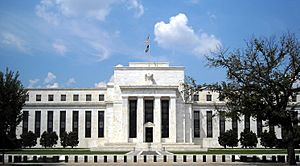National Monetary Commission facts for kids
The National Monetary Commission was a special group created by the U.S. Congress in 1908. This happened after a big money crisis in 1907, often called the Panic of 1907. The Commission's job was to study the rules for banks in the United States and in major European countries.
The leader of the Commission was Nelson Aldrich, a powerful Senator. He took a team of experts to big cities in Europe. They were surprised to see how much better Europe's money system seemed to work. They also noticed that currencies like the British pound, the French franc, and the German mark were more important in international trade than the U.S. dollar.
The Commission's reports and ideas became a main reason for creating the Federal Reserve Act in 1913. This law set up the modern Federal Reserve system, which helps manage the U.S. economy today.
Contents
Why the Commission Was Needed
After several money problems in the late 1800s and early 1900s, Americans realized they needed big changes to their banking system. One of the worst parts of these money crises before World War I was when people and businesses got worried about the future. They would rush to banks to take out all their money. This is called a "bank run."
To stop these runs, banks often had to temporarily stop people from taking out all their cash. Sometimes they would set a limit on how much money someone could take out each day, or they would stop all cash payments completely.
In some parts of the U U.S., like the Southeast and Midwest, there wasn't enough cash. So, local groups of banks called "clearinghouses" would print special emergency money. This temporary money helped people continue to do business. Stopping cash payments and printing emergency money was better than letting a crisis get worse. But people really wanted a new system that would prevent these problems from happening at all.
What the Commission Proposed
The plan suggested by the Monetary Commission aimed to create a new banking structure. It wanted to set up local groups of banks, which would then be part of bigger regional groups. All these would then connect to a national reserve association, with its main office in Washington, D.C.
Most banks in the country could join this central organization. Its main jobs would be similar to the big central banks in Europe:
- Holding and managing the country's bank reserves (money banks keep aside).
- Issuing money that could change in amount as needed (an "elastic" currency).
- Helping banks get cash for business loans (called "rediscounting commercial paper").
- Acting as a place where the government could keep its money and pay its bills.
The Commission believed its plan would prevent any single group, whether political or financial, from controlling the new system.
The Commission's Reports

The Commission published 30 detailed reports between 1909 and 1912. These reports gave a complete and official look at banking systems from the late 1800s and early 1900s. They covered many topics, such as:
- U.S. financial laws.
- Banking laws in different U.S. states.
- The history of banking in Canada.
- The money and banking systems of England, France, Germany, and other countries.
These reports included essays written by top experts, along with many tables, charts, and copies of important documents. Some volumes even had transcripts of speeches, interviews, and hearings. The reports were printed by the U.S. Government Printing Office. The final report included the Commission's ideas and a draft law to create a national reserve association in the United States.
How the Commission Changed Things
The plan the Commission presented was meant to be fair and not favor any political party. The report was agreed upon by both Republican and Democratic members. However, it didn't get strong public support. This was partly because it seemed too much like a central bank, and many people didn't trust its main author, Senator Nelson Aldrich.
Even though the plan itself wasn't fully accepted, the Commission's report got many people talking about banking reform. During the 1912 presidential election, two political parties spoke out against the National Monetary Commission's plan. The winning Democratic Party, led by Woodrow Wilson, specifically said they were against any plan involving a central bank.
However, many of the ideas from the Commission's plan were later included in the banking bill that became the Federal Reserve Act. This law created the central banking system of the U.S. and gave it the power to print official money. The bill was introduced in Congress on June 26, 1913, and became law on December 23, 1913.

